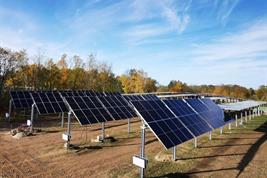12.12.2024

On 12 December, the Leibniz-Centre for Agricultural Landscape Research (ZALF) officially opened an experimental agri-photovoltaic plant on its premises in Müncheberg. The system, with a nominal output of 582.4 kWp and 832 PV modules, is designed to generate around 650 MWh of electricity per year. This corresponds to about 40 per cent of ZALF's electricity requirements at the Müncheberg site. Special features are the 2D and 3D rotatable modules, which flexibly adjust to the position of the sun. The construction was funded by the state of Brandenburg with €2.27 million to strengthen the energy security and research activities of non-university research institutions. At the same time, the plant will serve as a test field for scientists to investigate fundamental research questions relating to cultivation in a combined land use with arable farming and photovoltaics.
Agri-Photovoltaics (Agri-PV) is the simultaneous use of agricultural land to produce crops or livestock and to generate solar electricity. It differs from the already widespread open-field systems, where no agricultural use is possible between the solar modules. The spread of Agri-PV in Germany is still in its first stages, but is being driven forward by pilot projects, technical developments and the adaptation of the legal framework. At ZALF, the SynAgri-PV project [https://www.ise.fraunhofer.de/en/research-projects/synagri-pv.html] is already working intensively on this.
The Agri-PV system can cover up to almost half of the energy consumption at the ZALF campus and will help the research facility to improve its independence from external electricity suppliers. ZALF successfully applied for funding from a support program of the Ministry of Science, Research and Culture of the State of Brandenburg (MWFK) with the plans for this system.
Agri-PV research in dialogue
The new agrivoltaic system at ZALF will be used to address research questions that are being developed together with stakeholders from agriculture, politics and society as part of the Innovation Centre for Agricultural System Transformation (IAT).
Possible topics that could be investigated with the agrivoltaic system include the effects of the modules on the microclimate of the air and soil and their potential influence on plant growth. Issues such as protecting crops from extreme weather conditions, adapting crop rotations or the impact on biodiversity and economic viability could also be explored. In the long term, the data will be fed into models to optimise shade, energy and yield.
Field day in spring
The experimental plant marks the beginning of intensive research. ZALF would like to use this opportunity to initiate new collaborations and give interested parties an insight into the results. A public field day is planned for spring 2025. ZALF will provide information about this event in due time.
Project partners:
- PV-Service GmbH
- REM TEC GmbH
- Omexom GmbH
Funding
Grant from the State of Brandenburg under the "Directive of the Ministry of Science, Research and Culture of the State of Brandenburg to Strengthen Energy Resilience and to Secure the Research Activities of Non-University Research Institutions (3/23-12/24)".
Text disclaimer:
This text was created using artificial intelligence. The text has been carefully reviewed and edited in accordance with ZALF's AI guidelines.
